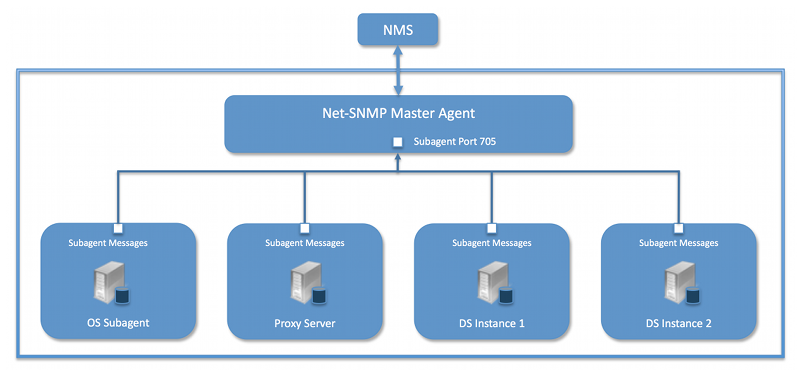SNMP implementation
In a typical SNMP deployment, many production environments use a network management system (NMS) for a unified monitoring and administrative view of all SNMP-enabled devices.
The NMS communicates with a primary agent, whose main responsibility is to translate the SNMP protocol messages and multiplex any request messages to the subagent on each managed device, such as a PingDirectory server instance, a PingDirectoryProxy server, a PingDataSync server, or an OS Subagent. The primary agent also processes responses or traps from the agents. Many vendors provide commercial NMS systems. Consult with your NMS system for specific information.
The server contains an SNMP subagent plugin that connects to a Net-SNMP primary agent over TCP. The main configuration properties of the plugin are the address and port of the primary agent, which default to localhost and port 705, respectively. When the plugin is initialized, it creates an AgentX subagent and a managed object server and then registers as a management information base (MIB) server with the server instance. After the plugin’s startup method is called, it starts a session thread with the primary agent. Whenever the connection is lost, the subagent automatically attempts to reconnect with the primary agent. The server’s SNMP subagent plugin transmits only read-only values for polling or trap purposes. Set and inform operations are not supported. SNMP management applications cannot perform actions on the server on their own or through an NMS system.

|
The PingDirectory server was designed to interface with a Net-SNMP (5.3.2.2 or later) primary agent implementation with AgentX over TCP. Many operating systems provide their own Net-SNMP module. However, Service Management Automation (SMA) disables some features present in the Net-SNMP package and only enables AgentX over UNIX Domain Sockets, which cannot be supported by Java. If your operating system has a native Net-SNMP primary agent that only enables UNIX Domain Sockets, you should download and install a separate Net-SNMP binary from its website. |